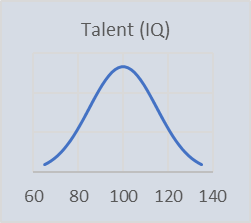So, what’s the difference between these two experiments? In the second one, the subject’s amygdala (the emotional center of the limbic system, which triggers the fight or flight response) lights up like a Christmas tree when viewed with functional MRI! The explanation for this strong reaction is that the ambiguity of the second deck induces anxiety[1]. The subject knows there is one red and one black card, but what are the rest of the cards? Experiments like these bring scientific rigor to the emerging field of Behavioral Economics.
The relevance to probability management is that in our discipline, uncertainty is communicated in SIPs (Stochastic Information Packets), which are randomly shuffled potential outcomes similar to the first deck of cards. With SIPs, the uncertainty is unambiguous. You can take your time and look at each number in advance, which is comforting, but you know only one will be selected when the uncertainty is resolved. This is unlike traditional simulation, which generates random experiments on the fly, thereby driving accountants bonkers. Instead, SIPs contain metadata, including provenance, so you know that they are not just something the cat dragged in. Then, when the accountants come knocking, you can say, “We are basing our decision on fifty million deterministic numbers. How about auditing these for us?” That’ll get them off your back for a few days.
This discussion also highlights the difference between the two famous feuding schools of probability, the frequentists and the Bayesians. The frequentists define the probability of an event as the proportion of times the event occurs in a large number of identical experiments. For example, if you actually wagered on Red over a thousand standard shuffled decks, you would win about 500 times, and the relative probability of red to black would be defined as 50%. A true frequentist might have trouble with deck two because they would not know how to define the repeatable experiment. The Bayesians, for whom my father was a major evangelist, think of probability as being subjective, and determined by the risk-neutral wager you would make on the outcome. Bayesians have no problem putting a relative probability of 50% on the outcomes of experiment two, which suggest that perhaps members of the two schools could be identified by what their amygdalae do in MRI machines.
Uncertainty Light
In his book The Black Swan, Nicholas Taleb coined the term Ludic Fallacy to warn against "the misuse of games to model real-life situations." His warning should be heeded. However, I define the Ludic Fallacy-Fallacy to be the belief that you can manage real-life uncertainties without first understanding the simple arithmetic of dice, cards, and spinners. One thousand auditable potential outcomes may not contain any black swans, but it is way better than the industry standard of using a single average number to represent an uncertain future.
And speaking of games, an associate’s son is a star Little League baseball player. During the regular season his team dominated the other local teams, composed of kids he had known and played against for years. They easily made it into the playoffs with teams from other cities. At that point, facing the ambiguity of the unknown opposing players, his mother told me that the poor kid’s amygdala went up in flames of pre-game anxiety. They made it all the way through the playoffs, finally losing in a tight game in the fourth and final round. I asked if his anxiety had persisted during the championship play, and was told that by the second game “he had learned to play with deck two.”
So, think of probability management as “Uncertainty Light,” designed to calm those with Post Traumatic Statistics Disorder during the regular season. But don’t be lulled into complacency. You’ll never make the playoffs if you can’t deal with the ambiguity of the second deck.
To learn probability management applications, sign up for our Fort Worth workshop or an upcoming webinar.

























